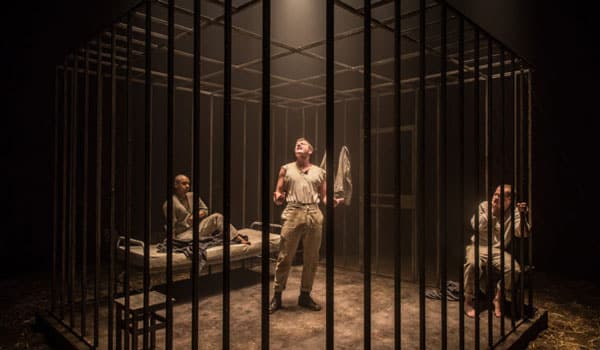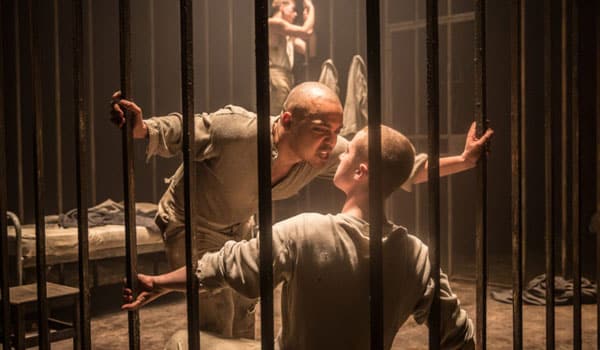
Deathwatch
Print Room At The Coronet
14 April 2016
3 Stars
About as French as a pasty, and just as heavy.
Jean Genet is running amok on our London stages at the moment. After scandalising us in The Maids at the Trafalgar Studios he’s back to finish the job with David Rudkin’s translation of Deathwatch at The Print Room, Coronet, directed by Geraldine Alexander. Three convicts trapped in the same small cell struggle to maintain social order as they compete for the favour of condemned murderer Green Eyes. To a modern audience this play’s claustrophobia facilitates a deconstruction of masculinity, and Genet enjoys provoking his audience by inverting societal codes of morality as the men glamourise and sexualise their brutality. Unfortunately, these noble aspirations are suffocated under laboured and repetitive text that never feels as dangerous or as visceral as it should.
 Having never been to The Print Room at the Coronet I was completely charmed if not a little intimidated by this startlingly beautiful and atmospheric space; the Turkish rugs and trinkets mounted on concrete walls gently reminded me that I will probably never be as cool and bohemian as them. The space is sumptuous, a dizzying warren with heavy fabrics, burnt bronze curiosities and candles in cages seeming to suggest an imminent sacrifice. (I noted with horror, this was the piano shamelessly ignobled as a bar.) And the pre-set was just as dramatic; a looming iron cage set centre stage whilst the rest of the space evoked a circus ring strewn with dirt and straw. Alexander did well to utilise the venue’s previous life as a cinema to lend a filmic quality to proceedings, including a mischievous drummer “boy” who heralds the beginning of the action.
Having never been to The Print Room at the Coronet I was completely charmed if not a little intimidated by this startlingly beautiful and atmospheric space; the Turkish rugs and trinkets mounted on concrete walls gently reminded me that I will probably never be as cool and bohemian as them. The space is sumptuous, a dizzying warren with heavy fabrics, burnt bronze curiosities and candles in cages seeming to suggest an imminent sacrifice. (I noted with horror, this was the piano shamelessly ignobled as a bar.) And the pre-set was just as dramatic; a looming iron cage set centre stage whilst the rest of the space evoked a circus ring strewn with dirt and straw. Alexander did well to utilise the venue’s previous life as a cinema to lend a filmic quality to proceedings, including a mischievous drummer “boy” who heralds the beginning of the action.
Genet, who himself spent time incarcerated explores the elasticity of male relationships in enforced proximity. The three cell mates are representative of different types of masculinity, Green-Eyes is their domineering alpha, Lefranc a cerebral beta-male whilst Maurice is fluttering and effete. At times, Green-Eyes, Maurice and Lefranc seem lovers, billing and cooing cradling each other in loving embraces. Then they are adversaries, desperate and brutal, threatening and cruel. In the course of their power struggles they undermine each-other and in doing so destabilise themselves. Joseph Quinn minces with the best of them as Maurice and brings much welcome levity; I enjoyed his flouncing and simpering as he drove a wedge between Lefranc and Green-eyes. However, the night, for me, belonged to Danny Lee Wynter who offered a lesson in stage presence proving that appearance isn’t everything. Even though he was smaller and less spritely than the others, the seasoned performer owned the stage without trying. Ironically it was he who personified Green-eyes’ assertion, “A real man doesn’t boast, he knows he’s a man.”

Rudkin’s translation of Genet’s poetic text is sometimes florid and twirling, sometimes oblique and clunky. As such, the examinations of masculinity rarely hit their marks and the opportunity to make a meaningful commentary on our current gender politics is lost. They say that predators are at their most deadly when caged in; all that potential slowly winding up like a coiled spring, but I never felt there was a chance the three convicts or their relevance might spill into my world and as such felt neither fearful nor moved by them. Perhaps Deathwatch is missing just a little bit of je ne sais quoi.
Deathwatch runs at the Print Room until 7 May 2016


